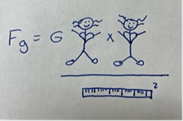“Pick a flower on Earth and you move the farthest star,” Paul Dirac (Nobel Laureate in Physics, 1933).
On Valentine’s Day, we celebrate the attractions between us. We measure attraction and mark it in time, actions and perhaps a heart-shaped box of chocolates. Sir Isaac Newton had other ideas.
As early as 1605, Johannes Kepler described the path of the Planets traversing in elliptical orbits around the Sun, but Newton wondered why. What attracted the Planets to the Sun? What is the cause? It is said that these answers began to take form when, due to the plague closing Cambridge University, Newton moved to his childhood home in Lincolnshire, England. The story goes that while in his garden, an apple fell from a tree and set his mind into action. He thought that something must be acting on the apple to pull it down to the ground, or it would have stayed where it was.
He also reasoned that this something was a force and must work on all objects with mass, including the Moon, the Earth and us. Newton’s calculations produced the laws of motion still used today to describe and calculate rocket trajectories, satellite motions and the ISS. From these formulas, Newton understood that the force between the objects was related to the mass. Newton did not discover gravity but described how gravity is universal and that all mass objects attract each other with the force of gravitation. The larger the mass of the object, the stronger the force. The greater the distance between the objects, the weaker the force. So the Earth’s gravitational force affects the Moon, while the Moon’s gravitational force affects the Earth. And as stated, we are also composed of mass. Our mass attracts the mass of the chair we sit on or the person next to us, and their mass attracts ours. Although we may not feel it, as our mass compared to Earth is tiny, we can now calculate this force thanks to Newton and later scientists.
Despite centuries of scientific investigation, there are still many questions on how exactly gravitation works and how it measures with very large or small forces, such as from black holes or protons. These answers are yet to come, but for this year, perhaps skip the flowers or candy, gift your valentine an apple in honor of Newton, and celebrate the force between us.









